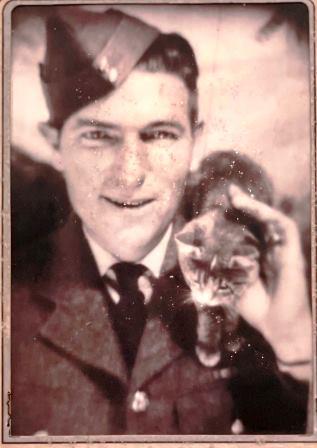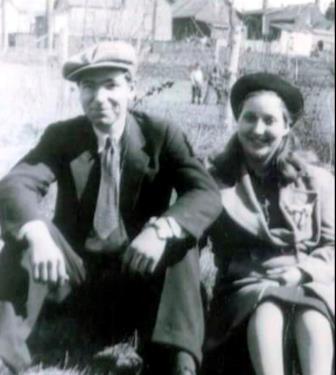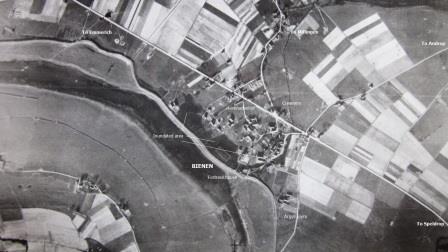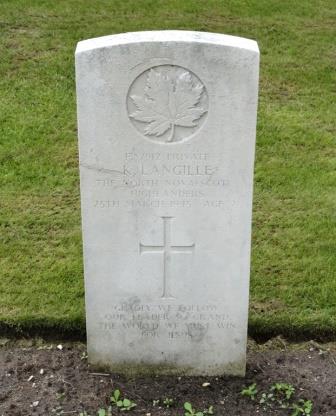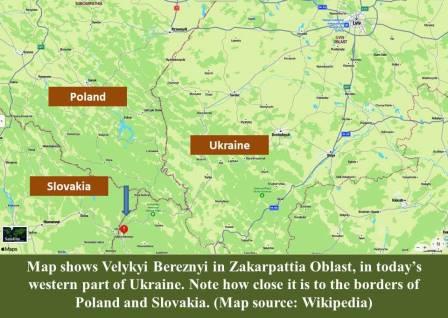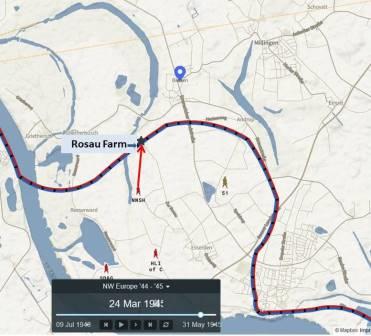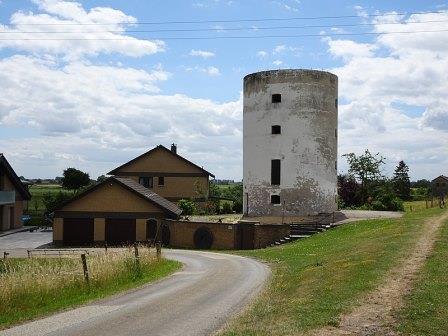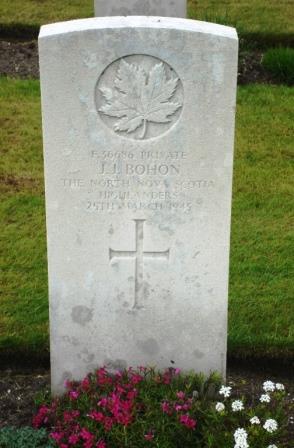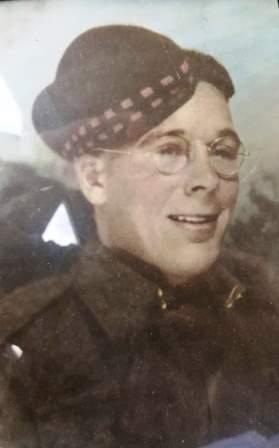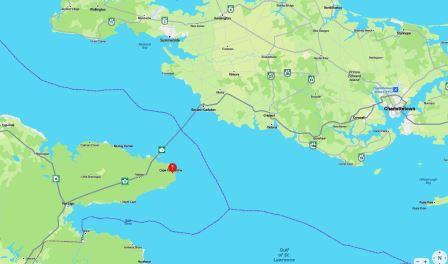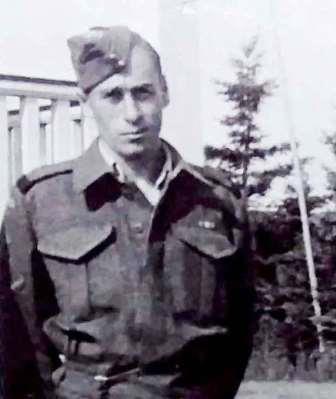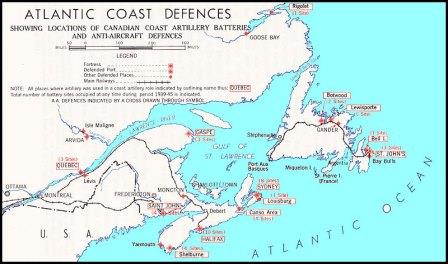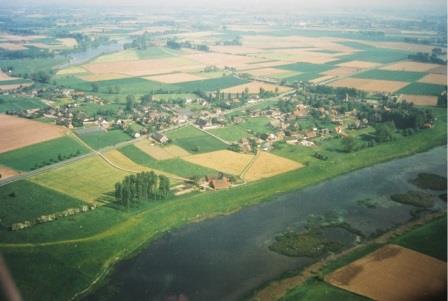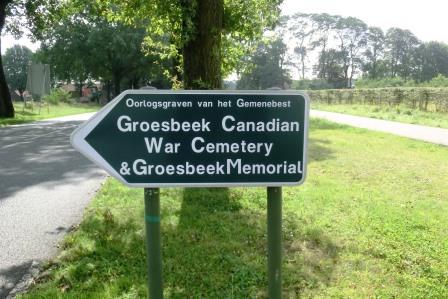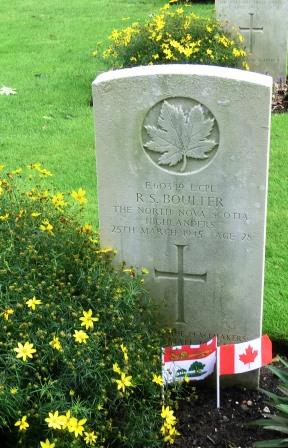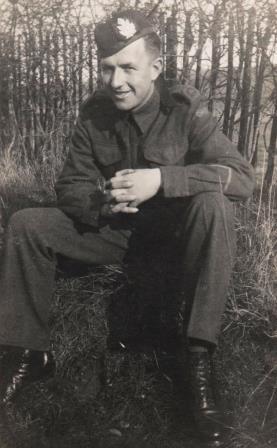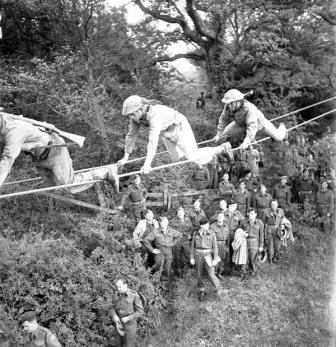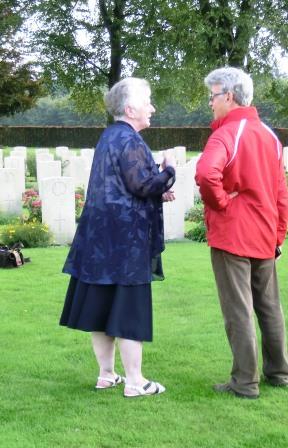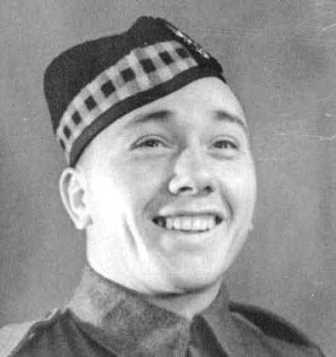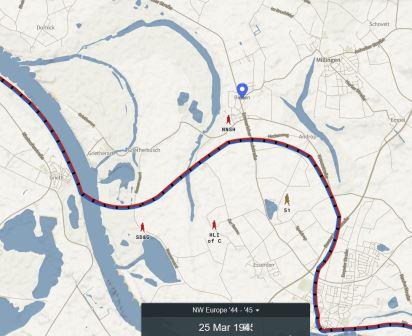March 26, 2023. On a list of 39 soldiers from the North Nova Scotia Highlanders Regiment who were killed during the Battle of Bienen in Germany on March 25, 1945 and are buried in the Canadian War Cemetery in Groesbeek, The Netherlands, photos were missing for 12 names.
As mentioned in previous postings in this series, the date of the battle was very meaningful. “…They died on my birthday! I was just one year old!…” Pieter exclaimed.
One of the names on the list of missing photos was Marven Glenroy HARVEY.
…Marven was one of 8 brothers serving during WWII….
After being unsuccessful in contacting family, Pieter asked Carrie Hogan, Branch Manager of Royal Canadian Legion Hants County Branch No 9 in Windsor, Nova Scotia for help. Carrie explained that she’d “…. have to reach out to some of our older members here who seem to know everyone….”
Shortly after sending that message, Carrie wrote back, saying that she reached “…Victor Harvie, Marven’s nephew…” who came to the Legion in person with a photo and information. “…Please find attached photo of Marven Harvie/Harvey. He was one of 8 brothers who were in the service during World War II. The brothers were Avard, Burrell, Ernest, Ervin, Edmond, Victor, Garnet and Marven. I was told that this was the only family in the British Commonwealth to have 8 sons in the army during World War II….”
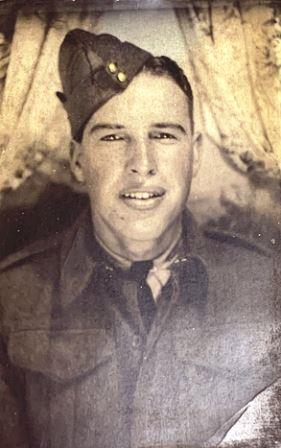
Marven Glenroy Harvey. (Photo courtesy of Victor Vernon Harvie and James Harvie)
…Marven enlisted at the age of 18….
Born October 2, 1925 in North Noel Road, Nova Scotia, Marven Glenroy HARVEY (surname also spelled HARVIE) was the son of Richard ‘Dick’ and Sarah ‘Pink’ (nee White) Harvie. At the time he enlisted on May 3, 1944 at the No. 6 District Depot in Halifax, Nova Scotia, he was working as a labourer for lumber merchant M. G. Anton in Kennetcook, Nova Scotia.
On May 19, 1944 he was transferred to No. 60 Canadian Infantry Basic Training Centre (CI (B) TC) in Yarmouth, Nova Scotia. As he was under 19 years of age, the minimum age for overseas service, he was eligible for extended infantry training.
In an interview for his Personnel Selection Record, it was recorded that Marven was “…bashful… and states that he has stuttered since childhood…” He liked to participate “…in the usual sports and personal recreations include reading adventure stories and attending the movies…”
A few weeks later, on June 17, 1944, he was assessed as being “…a particularly well motivated young man, anxious to serve, willing, conscientious…. Excellent deportment to date, is trying very hard – deserves every encouragement…”
On August 13, 1944, he was sent to A14 Canadian Infantry Training Centre (CITC) in Aldershot, Nova Scotia for additional training. His examiner noted that he “…completed his basic infantry training, and his attitude toward overseas service is good….” It was recommended that Marven go overseas with the Canadian Infantry Corps in a non-tradesman capacity.
…Marven was sent overseas shortly after his 19th birthday….
On November 21, 1944 he left Canada for the United Kingdom, arriving on November 28, 1944, most likely on the same transport as John Joseph BOHON and Kitchener ‘Kitty’ LANGILLE. Upon arrival in the United Kingdom on November 28, 1944, like Bohon and Langille, he was assigned to No. 3 Canadian Infantry Reinforcement Unit (CIRU).
On January 8, 1945 he was sent to Northwest Europe as part of the 10th Battalion. On February 22, 1945, Marven was transferred to the North Nova Scotia Highlanders, joining the Regiment in Calcar, Germany, on a day in which they had many casualties – 9 killed and 31 wounded, according to the war diary for that day.
…Marven lost his life in the Battle of Bienen ….
By March 20, 1945, Allied troops were on the banks of the Rhine River for Operation Plunder, a military operation to cross the Rhine on the night of March 23, 1945. (See https://en.wikipedia.org/wiki/Operation_Plunder) They got as far as Bienen, when troop movement stopped due to blown bridges across the Rhine in that area.
On March 25, 1945, the Regiment’s task was to pass through the 7th Argyll and Sutherland Highlanders who had been stopped in front of Bienen. It was Palm Sunday, one week before Easter.
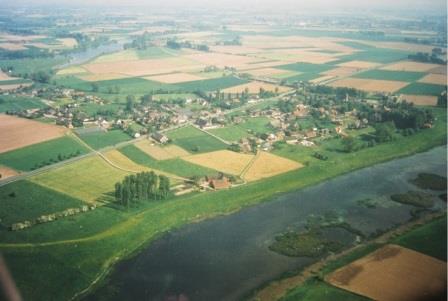
Post-war aerial of Bienen (view to the southeast towards Rees). The aerial clearly demonstrates the tactical importance of Bienen, laying astride the narrow neck of land. The main road from Rees to Emmerich (nowadays Emmericher Strasse) runs straight through Bienen. (Photo source: http://www.WW2Talk.com and identified as ‘Courtesy Becker’)
Two attempts were made that day to capture Bienen, Phase I in the morning, and, following heavy losses, Phase II began in the afternoon and ultimately cleared the village.
In ‘No Retreating Footsteps’ author Will Bird explained that Major Lloyd C. Winhold, the commander of ‘C’ Company, “…knew his men had to cross a wide open area and was insistent on a smoke barrage. So it was agreed that fifteen minutes of artillery fire and smoke would be put down and the time was arranged so that ‘C’ Company would get into the village just as the shelling stopped…”
In the article ‘Too Close To The Guns!’ in Canadian Military History, Volume 12, Numbers 1& 2, Winter/Spring 2003, pp.5-28, author Lee Windsor noted that the afternoon attack began with covering fire. “… Winhold’s ‘C’ Company hurried across the dyke level-crossing and in behind Argyll Farm where they proceeded to form up with the Dragoon Guards tanks and Wasps…”
Like Louis Sexton, Marven was in ‘C’ Company, which had a more exposed route to Bienen, going across 457 metres (500 yards) of open ground to reach the first houses at the edge of the village. The Company reached Bienen but had 33 casualties within 15 minutes – 10 killed and 23 wounded.
Major Winhold had anticipated this, as Will Bird noted that before the attack “…Winhold asked for ‘Crocodiles’, which would have saved the heavy casualties, but none were available. He asked for a longer barrage but was informed that it had been difficult enough to have the shoot for fifteen minutes…”
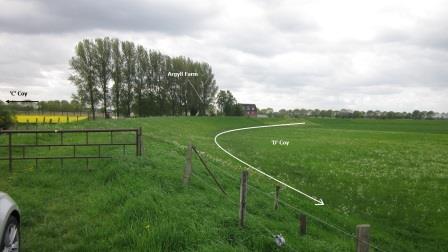
‘D’ Company attacked along the dyke on western edge of Bienen, while ‘C’ Company proceeded across open ground. (Photo source: http://www.WW2Talk.com and identified as ‘Courtesy Becker’)
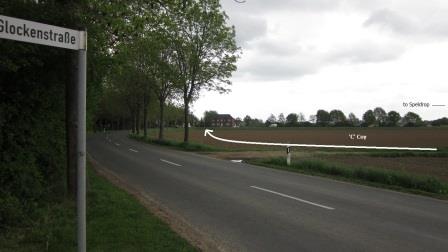
‘C’ Company moved towards Bienen along the road in the direction of the crossroads. The brick building identifies the location of Argyll Farm. (Photo source: http://www.WW2Talk.com and identified as ‘Courtesy Becker’)
The Regimental War Diary recorded that after the second phase of the battle started at 2 pm, the “…next report received at 1445 hours was that ‘C’ Company was in the first houses on the fringe of the town after suffering heavy losses….”
The one day battle was devastating in terms of casualties, both dead and wounded, including Marven Glenroy Harvey.
…Marven is buried in the Canadian War Cemetery in Groesbeek ….
Like Clifford BATEMAN, John Joseph BOHON, Ralph Schurman BOULTER, and Charles ‘Marshall’ CARSON, Marven Glenroy HARVEY, Kitchener ‘Kitty’ LANGILLE, and Louis SEXTON, Marven was temporarily buried on Monday, March 26, 1945 in the military cemetery in Rees, Germany before being reburied the following year in the Canadian War Cemetery in Groesbeek, The Netherlands.

Grave of Marven Glenroy Harvey at the Canadian War Cemetery in Groesbeek, The Netherlands. (Photo source: http://www.findagrave.com)
Besides losing Marven, the family lost another son, James ‘Burrell’ Harvie, on October 27, 1942.
Thank you to Carrie Hogan for helping in the search for family and a photo. Thank you to Victor Vernon Harvie and James Harvie for providing a photo and information, and to Sandra Harvey.
Thank you to all who have helped Pieter to find family members of North Novies killed in this battle. Coming up in Part 9: Marvin William McGregor.
If you have a story to tell, please let Pieter know. Email him at memorialtrail@gmail.com comment on the blog, or tweet to @researchmemori1.
© Daria Valkenburg
….Previous stories about North Novies killed during the Battle of Bienen and buried in Groesbeek….
- Clifford BATEMAN: https://onthewarmemorialtrail.com/2023/03/16/on-the-war-memorial-trail-the-battle-of-bienen-part-4-the-wwii-soldier-from-a-small-fishing-village-in-newfoundland-who-lost-his-life-in-germany/
- John Joseph BOHON: https://onthewarmemorialtrail.com/2023/03/18/on-the-war-memorial-trail-the-battle-of-bienen-part-5-the-wwii-soldier-whose-parents-immigrated-to-save-their-family-from-war/
- Ralph Schurman BOULTER: https://onthewarmemorialtrail.com/2023/03/07/on-the-war-memorial-trail-the-battle-of-bienen-part-2-the-wwii-battle-drill-instructor-from-oleary/
- Charles ‘Marshall’ CARSON: https://onthewarmemorialtrail.com/2023/03/12/on-the-war-memorial-trail-the-battle-of-bienen-part-3-the-wwii-soldier-from-cape-tormentine-who-lost-his-life-in-germany/
- Harry William DOUCETTE: https://onthewarmemorialtrail.com/2021/02/09/on-the-war-memorial-trail-atlantic-canada-remembers-part-6/
- Kitchener ‘Kitty’ LANGILLE: https://onthewarmemorialtrail.com/2023/03/21/on-the-war-memorial-trail-the-battle-of-bienen-part-6-the-wwii-soldier-from-new-glasgow-nicknamed-kitty/
- Austin Havelock MUNROE, plus a list of the 39 soldiers: https://onthewarmemorialtrail.com/2022/11/29/on-the-war-memorial-trail-the-search-for-a-photo-of-austin-havelock-munroe-is-on-youtube/
- Louis Allan SEXTON: https://onthewarmemorialtrail.com/2023/03/23/on-the-war-memorial-trail-the-battle-of-bienen-part-7-the-wwii-soldier-from-quebec-who-has-never-been-forgotten-by-his-family/
- Edison Alexander SMITH: https://onthewarmemorialtrail.com/2023/03/04/on-the-war-memorial-trail-the-battle-of-bienen-part-1-the-wwii-soldier-whose-body-shielded-a-wounded-major/
…Want to follow our research?….

If you are reading this posting, but aren’t following the blog, you are welcome to do so. Our blog address: https://onthewarmemorialtrail.com/.
 4 countries, 6 weeks, 7,000 km – an unforgettable war memorial journey in Europe….Daria’s book ‘No Soldier Buried Overseas Should Ever Be Forgotten‘ is available in print and e-book formats. Net proceeds of book sales help support research costs and the cost of maintaining this blog. For more information see https://nosoldierforgotten.com/
4 countries, 6 weeks, 7,000 km – an unforgettable war memorial journey in Europe….Daria’s book ‘No Soldier Buried Overseas Should Ever Be Forgotten‘ is available in print and e-book formats. Net proceeds of book sales help support research costs and the cost of maintaining this blog. For more information see https://nosoldierforgotten.com/
You are also invited to subscribe to our YouTube Channel: On The War Memorial Trail With Pieter Valkenburg: https://www.youtube.com/channel/UCJ591TyjSheOR-Cb_Gs_5Kw.
Never miss a posting! Subscribe below to have each new story from the war memorial trail delivered to your inbox.
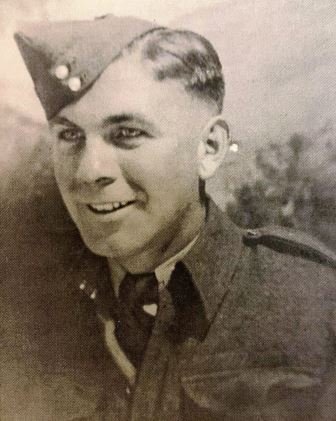
 After that, Judy Sexton wrote, saying “
After that, Judy Sexton wrote, saying “
